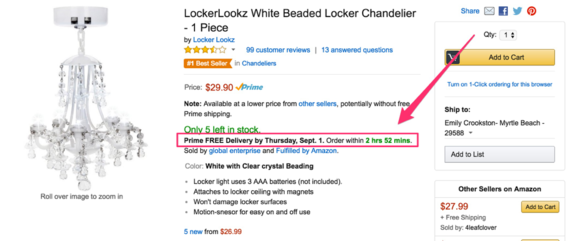You've probably noticed that you always (okay, maybe not always, since you're not a teenager) want what you can't have. Whether it's that super cute tunic that you saw in a boutique in Rehoboth and can't seem to find ANYWHERE else. Or that last bagel that the lady in front of you just bought, items in short supply somehow magically become more appealing.
Only it's not really magic. It's science.
If you want to use the psychology of scarcity to boost desire among visitors to your website (not to mention, boost conversion rates), it helps to understand why scarcity works.
Consider the following examples:
•During a classic psychological study performed in 1975, researchers placed two identical glass jars of cookies next to one another. The only difference between the jars was that one jar had ten cookies and the other contained just two. Though the cookies in the jars were identical, participants consistently ranked the cookies in the near-empty jar more highly.
•In Brooklyn, NY, there is a famous pizzeria called Di Fara. It is famous for being slow and for having long lines. One food critic, wanting to know what all the fuss was about, waited over an hour for a slice. And yet, Di Fara is always at the top of rankings of top pizzerias. The slices also cost $5--more than the average slice in NYC.
•Ayelet Fishbach, a professor of behavioral science at the University of Chicago set up a "smoothie sample tasting study" where for half of the participants, two researchers stood behind them in line. For the other half, no one stood behind the person tasting the smoothie. When a line formed behind participants, they reported that the smoothie tasted better.
Behavioral economists have been especially fascinated (and frustrated) by this phenomenon because scarcity in a market economy indicates a market failure--a failure of supply to seamlessly meet demand. Plus, lines are inefficient, since the order of the line doesn't reflect how much you'd be willing to pay.
But to shoppers and visitors to your website, lines signal value.
Why does scarcity sell?
The perception of scarcity triggers a deep primal urge within us to increase personal security. Going all the way back to when human beings lived in caves, the human mind is automatically programmed to attend to unfulfilled needs to ensure survival. So, when we know something is scarce, we feel compelled to focus on it, and our behavioral response is to obtain more for ourselves.
In the 'real world' lines signal scarcity. Of course, it's a little hard to create a line on your website. But you can still create the perception of scarcity.
We've all seen the signs designed to create a sense of urgency and scarcity:
"Act now!"
"For a limited time only!"
"Going out of business. Final liquidation sale!"
Scarcity is a common marketing technique. But few companies manage to get it right. The furniture company that seems to have a going-out-of-business sale every few months isn't fooling anyone.
What are the best ways to leverage scarcity on your website?
1. Limit your supply.
You can boost sales of a product or boost conversion rates for services by intentionally limiting the supply available. If you offer free consultations or free coaching sessions, for instance, constraining the supply is easy. You only have time to do so many of these meetings each week. Simply let people know how many spots are available in order to create a sense of scarcity. Which reminds me to ask you: Have you signed up for your free website assessment with me yet? There are only 2 more spots available!
See how that works? It's like creating a 'virtual line.' Alternatively, announce a limit on accepting new customers. Even something as simple as a banner on your website stating "Now accepting new clients" creates the perception that you might not be accepting new clients soon. With the limited supply, users will feel like they are getting something exclusive because they are.
2. Create scarcity of time.
Okay, so technically, this is urgency, not scarcity, but scarcity and urgency really go hand-in-hand. Creating a sense of scarcity of time basically explains the whole marketing strategy commonly known as Black Friday. If you want to generate excitement around a new product or service launch, put a time limit on it. And make sure to announce the end as a specific time or date, rather than simply saying "offer available for a limited time only." Amazon is a master at this with shipping countdowns (see image below). You can follow Amazon's lead by easily purchase countdown clocks to add to your website from places like Countdown Monkey and Scarcity Builder. WordPress also has a Page Expiration plugin that you could use for landing pages you create. This will influence users who are on the fence about buying to stop procrastinating so they don't miss the deal.
3. Create seasonal offers.
It's not quite time to start making snarky comments about trendy ways to consume pumpkin spice, but as Q4 approaches, it is time to start building marketing strategies around seasonal offers. Seasonal products and services are also a great way to create that sense of scarcity, since seasonal items have a built-in time limit. For the upcoming holiday shopping rush, have you considered a giveaway that you could offer to first comers? For example, the first 20 salon customers to make an appointment in December will receive a free boar bristle brush. You might also consider the idea of social proof here. Since people are more likely to accept the recommendation of people they trust, leverage that by making it easy for customers to share when they visit your website. And as the holidays approach, put in place a plan to highlight customer behavior on your website and on your company's social media. It's just another way to create the 'lining up' effect.
Using the psychological principle of scarcity can definitely increase sales and generate new interest in your services, but remember that scarcity marketing tactics only work if you are also developing a strong foundation of loyal customers. Again, scarcity is not magic. It's science.
Have another great idea for leveraging scarcity for your business?
Post it in the comments below or contact our team at Spring Insight and let us help you put your plan into action.
For more discussion about making psychology part of your business's marketing strategy, follow me on Twitter, Facebook, or Google+.
Erika Dickstein is a Web Strategist located in the DC metro area. She specializes in working with small businesses on creating strategic goal-oriented websites. You can connect with her at www.springinsight.com.


